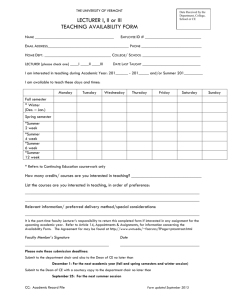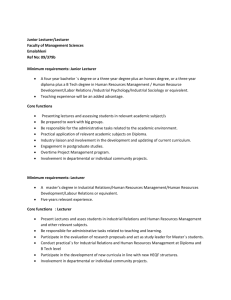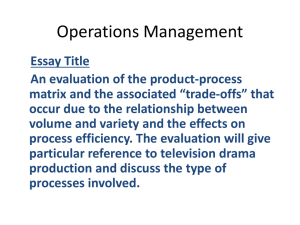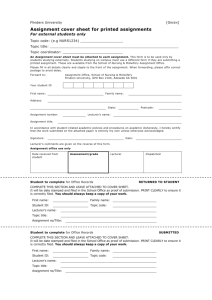STUDIEWIJZER BIJ HET VAK SYSTEM ENGINEERING (TBK
advertisement
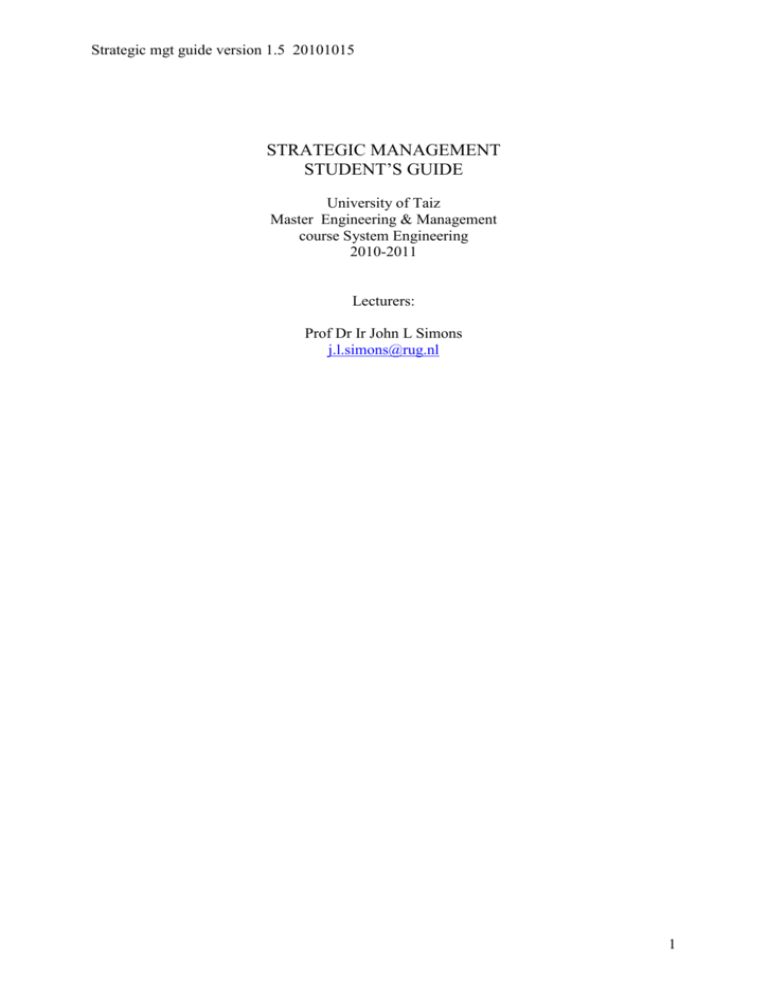
Strategic mgt guide version 1.5 20101015 STRATEGIC MANAGEMENT STUDENT’S GUIDE University of Taiz Master Engineering & Management course System Engineering 2010-2011 Lecturers: Prof Dr Ir John L Simons j.l.simons@rug.nl 1 Strategic mgt guide version 1.5 20101015 Introduction There are many definitions for Strategic Management. They have in common that the focus is on an organization’s long term decisions (market trends, where to expand, which new products, which required competences) in contrast with the operational and tactical decisions (production scheduling, logistics, pricing). In this course we take an engineering view, which means that strategic management is seen as a semi-rational decision process of the management of an organization to reach a new position in its environment. Throughout the course we will advocate that there are three steps in this process (i) understanding the strategic position of an organization in its environment (ii) making strategic choices at all management levels of an organization (iii) defining actions for change of structure, capabilities and resources. This view easily fits in an master program Engineering & Management, however we will sometimes dwell upon other more organic views on strategic management. As is the case for more management courses strategic management can best be learned in a real-life situation after sufficient experience at other management levels. This being the case, a university course can only simulate such conditions. Also due to time constraints of the course we will use strategic management information of real firms available on the internet, case material and as far as possible material from the home-organization of the students. Format Students must be open minded and self supporting in this course. After a short introduction of the field strategic management, working groups of 2 students will be formed. Each group has the task to “go through” the three (nine) strategic steps for either the home-organization of the student or a case-study (artificial) firm. The basic concepts, methods and techniques will be introduced by the lecturer. Students apply the concepts, methods and techniques and discuss the outcomes and reflect on strategic decisions made by real-life organizations as presented on the Internet. Results will be presented to the class according to a schedule. Students are invited to comment on each other presentations. The lecturer will comment and advice for subsequent course of action. Assignment Working groups of 2 students work during the course on two tasks 1. Formulation of a strategy based on the three steps of the engineering view. Choice of a firm (either real-life or case study) must be done in agreement with the lecturer. Either from “your” real existing firm or from the hypothetical or real firm of the course book, you have an (incomplete) description of the business processes and the managerial interventions of that firm over a certain period. This description may or may not refer to strategic management issues. The goal of the case study is to design a strategy for that firm. This requires that the case description should be transformed into a (hypothetical) strategic assignment. Typical questions that can help to formulate that assignment are (i) What is said about Porter’s five forces, SWOT, Culture, Product Development etc. One of your tasks is to select (for this case study) relevant strategic concepts and describe how they are defined and used in the case study. (ii) What is the underlying strategic question? Is the firm losing market share, e.g. suffering knowledge drain etc and is their strategic question something like What do 2 Strategic mgt guide version 1.5 20101015 we do wrong? Or is the firm doing fine, e.g. is there a form of organizational learning and is their basic question something like Which new opportunities are there for us? (iii)What is their implicit understanding of a business strategy? Which explicit definition can be used and to what extend is the strategy designable? Theoretically the design must be based on the three steps advocated in the course book, however the design process should always be fine-tuned (e.g. parts of the positioning can be skipped for some reason). Which steps are necessary and why? By doing so, you should be able to design a strategy and be able to explain the steps that you have taken. It also should guide you to define the structure of your final report, which could be construed as a scientifically based management report to the management of the firm of the case study. 2. (Non mandatory challenge for high quality teams.) Reflection on an application of a concept, method or technique used by a firm on the Internet and/or discussed during the lecture. Choice of concept in agreement with lecturer. The following aspects should be addressed: introduction of the firm, description of the subject/method/ concept including strong and weak aspects, theoretical applicability, practical applicability, own judgment on the application. This assignment is a contract between students and lecturer. Groups may consult the lecturer upon request during the course either in person or via email. The result of both tasks is one integrated report where the strategy (task 1) could be the main part and the reflection (task 2) could be discussed mainly in an attachment. The report (hard copy and an email attachment in Word, maximal 15 pages) must be delivered not later than 20.00 hr at day 12 as mentioned in the course schedule. Feed back and final marks will be given by the lecturer in the next week(s). Course schedule The course schedule contains three lecture hours per day during two weeks of each six days. Each day (three lecture hours) the progress of the working groups is supported by (i) First hour: theoretical introduction of key concepts by the lecturer (in the beginning only) or by the students themselves. (ii) Second hour: Exercise and discussion among group members on a chosen (theoretical) concept with and/or without supervision of the lecturer. Presentation by groups. (iii) Case study for final report. If wanted by student groups short presentation of encountered problems. Concluding feedback of the lecturer. The theoretical and key concepts of the first hour are given in the detailed schedule below. Schedule Topics Day 1 The nature of strategy, basic vocabulary, variety in contexts, strategy as design, strategy as experience, strategy as ideas, strategic development, the engineering view on strategy, team building, presentation schedule. Day 2 Strategic position : Environment, PESTEL framework, sectors, markets, SWOT analysis, Milestone products of strategic positioning. 3 Strategic mgt guide version 1.5 20101015 Day 3 Day 4 Day 5 Day 6 Day 7 Day 8 Day 9 Day 10 Day 11 Day 12 Strategic position : Capabilities, critical success factors, (core) competences, cost efficiency, organizational performance, benchmarking, knowledge management Strategic position :Purposes and culture, corporate governance, shareholders, stakeholders, business ethics, organizational culture, cultural web, mission statements Individual and student group consultancy, case study (re)planning Strategic choices : Business level, forces on business strategy, bases of competitive advantage, competition and collaboration, game theory Strategic choices : Corporate level strategy, value adding by corporate parent, corporate rationale i.e. portfolio manager, corporate portfolio i.e. policy matrix, corporate diversity, corporate control, Product, market and business development, International aspects. Strategic choices : Innovation and entreneurship, innovation dilemma’s, mergers and acquisitions, strategic alliances, success criteria Strategic action : Intended and emergent strategies, Organizing for success. Structural types i.e. simple structure, matrix structure, planning and control, (de)centralization, images of organizations, organizational dilemma’s, Milestone products of strategic action. Strategic action : Resourcing, managing people, information, finance, technology, diffusion of technology, organizing technology development Strategic action : Managing strategic change, diagnosing change, organizational cultural context, change management, communicating change, power and political processes. Milestone reflection. Last consultancy for final report Textbook(s) G. Johnson, K. Scholes and R.Whittington, Exploring Corporate Strategy, Prentice-Hall. See http://vig.pearsoned.co.uk/catalog/academic/product/0,1144,0273731556,00.html This book is the primary mandatory textbook for the course. It is a widely used textbook with a supporting website for lecturers and students and presents general strategy methods and techniques. To address the technological aspects two other books are used (available in the library) R. Burgelman, C. Christensen and S. Wheelwright, Strategic Manegement of technology and innovation McGrawHill. See http://www.mcgraw-hill.co.uk/html/0071263292.html and N.Harrison and D Samson, Technology Management McGrawHill. See http://www.mcgrawhill.com.au/html/9780072383553.html . Assessment format The assessment is 100% on the basis of the final report. Intermediate presentations are mandatory however for training purposes and feedback only. 4
